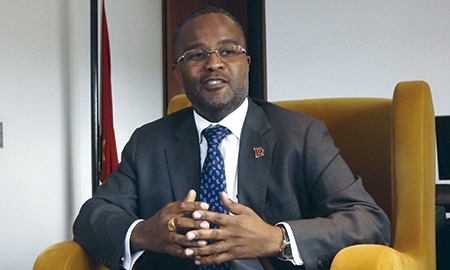What makes Angolans so positive about their prospects in the globalized 21st century? Now that the country’s destiny is back in the hands of its people, they have come to realize they have been granted a unique opportunity to reconfigure its economic fundamentals and make up for lost time.
Secretary of State for Transport José Joao Kuvingwa is one of the public officials tasked with growing the transport sector in a way that will allow it to serve the far more diversified economy.
“Obviously, a country that wants to achieve a higher level of development cannot be dependent on a single branch of the economy or a single natural resource as its source of income,” Mr. Kuvingwa says. “Only by integrating all areas can development be sustainable. And an efficient transport network is the transversal tool that makes it work.”
Intermodality is a natural as well as a necessary requisite for the development of integrated transport networks, given Angola’s geographical characteristics and existing infrastructure.
To meet the challenges, the government welcomes proposals for public-private partnership (PPP) agreements. “It is an area in which we have seen clearly positive results and would like to see them repeated,” says Mr. Kuvingwa.
“ONLY BY INTERGRATING ALL AREAS CAN DEVELOPMENT BE SUSTAINABLE. AND AN EFFICIENT TRANSPORT NETWORK IS THE TRANSVERSAL TOOL THAT MAKES IT WORK”
JOSE JOAO KUVINGWA
Secretary of State for Land Transport
--------------------------------
“WE WILL WORK TO RAISE THE STANDARDS FOR TRANSPORTATION OF GOODS BY ESTABLISHING PARTNERSHIPS WITH MAJOR LOGISTICS COMPANIES”
DR. CELSO RODRIGUES DE LEMOS ROSAS
Chairman of the Caminho de Ferro de Luanda rail line |
The Port of Luanda, where the infrastructure is owned by the state but operations are carried out by private entities such as
Multiterminais and Sonils, is a prime example.
Secretary of State for Civil Aviation Mario Miguel Domingues says his remit is “to create a civil aviation authority that keeps pace with the development of all other sectors of the economy and that ensures Angola’s enormous investments in human capital, technology and the environment produce results.”
The government supports efforts to promote Angola as a tourist destination with new airports serving national and international passengers nearing completion.
The nation’s airline, TAAG, has been restructured and enhanced with a new fleet of Boeing airplans.
The International Civil Aviation Organization, at the Luanda government’s request, strictly audits maintenance and safety controls for all of its aircraft.
Act locally, think regionally might serve to characterize the Luanda government’s thinking on transport, especially regarding plans for linking its road, rail, maritime and air transport assets into three east-west corridors originating at upgraded versions of Angola’s principal ports, and at least one more corridor running north to south.
Not only will they encourage contact and commerce between inhabitants on the 1,000 mile-long coastal strip and the country’s huge hinterland, but also provide access to the Atlantic for the mineral exports of Angola’s landlocked neighbors, Zambia and the Democratic Republic of the Congo.
Thanks to the Lobito corridor, originating at the Port of Lobito and linking the Benguela railway to Moxico on Angola’s eastern border, those countries have cut shipping times and distances by one-third.
Mile for mile, rail transport is set to remain the only way of enabling movement of goods and people across the Angolan hinterlands for some time and a key factor in creating a sense of community and national identity that bridges regional divisions.
Dr. Celso Rodrigues de Lemos Rosas Souza is Chairman of the Caminho de Ferro de Luanda rail line that has 300 miles of track from Bungo to Malanje, servicing numerous provinces. “Angola’s ports and railways are extremely competitive for freight, particularly in medium and long haul, as well as its advantages in terms of load capacity.”
With technical assistance and financing from China, Angola began reconstructing its war-damaged railways in 2002. “Human capital development was made a priority during this rehabilitation,” says Dr. Souza, “Today we have a better network, we have the locomotives and carriages to ensure the operability of the lines but we still must modernize our infrastructure and make use of the technology at our disposal.”
He added: “We will work to raise the standards for transportation of goods by establishing partnerships with major logistics companies and build commercial agreements that will promote long term relationships with our clients.”

0 COMMENTS